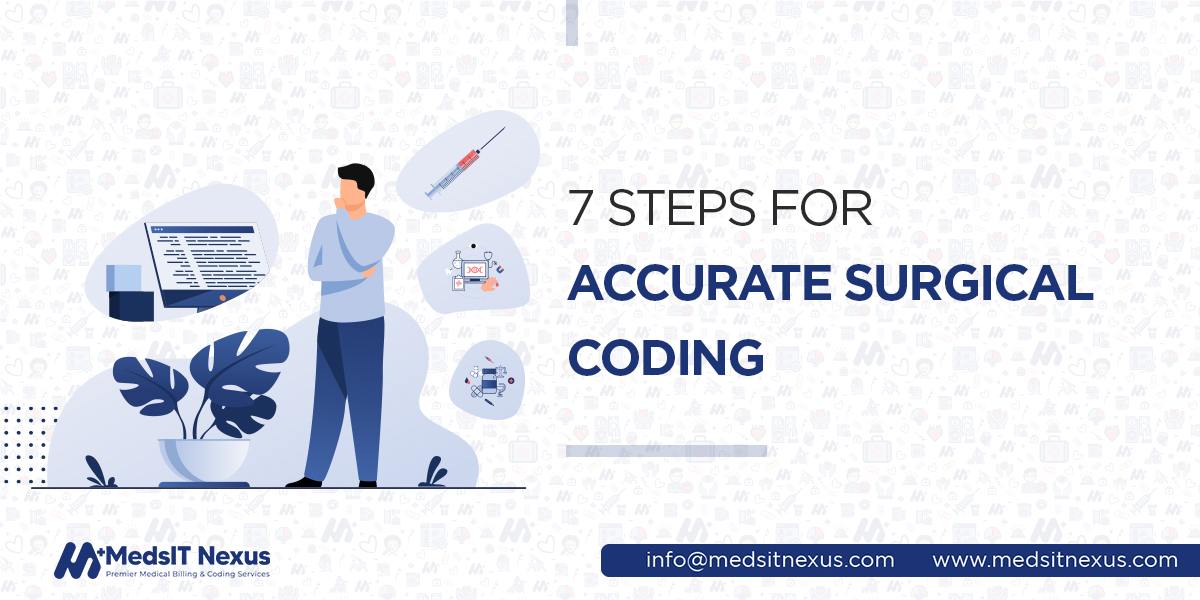7 steps for accurate surgical coding

Coding surgical reports can be an intricate and challenging process for coders aimed at precision and accuracy. With complex procedures, multiple codes, modifiers, and frequent changes in surgical coding guidelines, the process can be daunting for even the most experienced coders. However, accurate surgical coding is essential for healthcare organizations to receive proper reimbursement and prevent legal issues. Accurate surgical coding is crucial for financial purposes and for maintaining the healthcare system’s integrity and credibility. By meticulously breaking down the coding process into seven distinct steps, medical coders can effectively navigate the regulations and guidelines to ensure that the correct codes are assigned.
Such a structured approach enables coders to maintain high efficiency and productivity while reducing the risk of errors and inaccuracies. Therefore, we are here with 7 steps for accurate surgical coding. By following these steps, coders can approach coding with a level of organization and systematic efficiency that will guarantee a successful outcome
Seven Steps to Correct Surgical Coding
Surgical coding refers to the process of assigning specific codes to medical procedures performed during surgery. In surgical coding, each procedure performed during surgery is assigned a specific CPT code corresponding to a particular surgical technique, anatomical location, or body part.
Let’s move on to step-wise surgical coding guidelines.
- Review the header of the report
- Obtain prior authorization before surgery (If necessary)
- Review the documentation
- Review the CPT code book and make preliminary code selection
- Review policies and eliminate the extras
- Append modifier(s)
- Double-check your codes
Review the header of the report
The header of a surgical report is the document’s first section and typically contains essential information such as patient demographics, surgeon and assistant names, the date of the procedure, the surgical facility, and the procedure performed.
Guidelines for Reviewing the Header of a Surgical Report
To validate the header of a surgical report effectively, coders should follow specific guidelines. The following guidelines ensure that the correct procedure code is selected, proper documentation is in place, and relevant diagnosis codes are identified.
- Verify patient and physician information.
- Confirm the date and time of the procedure
- Identify the procedure and site
- Determine the surgical approaches
Example
Preoperative diagnosis: Osteoarthritis of the hip joint
Postoperative diagnosis: Osteoarthritis of hip joint resolved
Surgical procedure: Total hip replacement, i.e., hip arthroplasty
Obtain prior authorization, if it is required, before surgery
When it comes to surgery, prior authorization is a tedious and time-consuming task. However, it is an essential step in accurate surgical coding.
Obtaining prior authorization is essential for various reasons, such as ensuring that the patient’s insurance will cover the surgery’s cost and help prevent denials or delays in payment. Moreover, it reduces the risk of fraud and abuse by ensuring that surgeries are only performed when medically necessary.
Steps to obtain prior authorization
Step 1:
Verify insurance coverage and benefits by confirming the patient’s insurance plan, deductible,
co-payments, and exclusions or limitations.
Step 2: Obtain the necessary documentation, such as
medical records, diagnostic tests, and a procedure description.
Step 3: Submit the prior
authorization request to the patient’s insurance company or a third-party payer.
Review the documentation
Documentation serves as the primary source of information for surgical coders. It includes medical records, operative reports, progress notes, diagnostic tests, and other relevant documentation.
Importance of reviewing the documentation
Reviewing
the documentation is necessary to determine the procedure’s precise nature, the approach used, or
any complications encountered. Surgical coders may struggle to assign the correct codes without
accurate and complete documentation, leading to incorrect billing and possible legal ramifications.
Common Documentation Errors to Avoid
- Lack of specificity
- Incomplete documentation
- Inaccurate documentation
- Errors due to copy-pasting or using templates
Review the CPT code book and make a preliminary code selection
CPT is named for Current Procedural Terminology, a set of codes used to describe medical, surgical, and diagnostic services. The CPT code book is an essential tool for coders in identifying and assigning the appropriate codes to medical procedures.
The AMA publishes the CPT code book annually, which includes a comprehensive list of codes, descriptions, and guidelines for coding procedures.
What are the seven sections of CPT coding?
The CPT code book is organized by section, which includes Evaluation and Management, Anesthesia, Surgery, Radiology, Pathology, Laboratory, and Medicine, and each of these sections is further divided into subcategories. Each section includes codes that are specific to that area of practice. In surgical coding, the Surgery section of the CPT code book is the most critical section to review.
Tips for reviewing the CPT code book
- Review the code descriptors
- Use updated CPT codes
- Understand the coding guidelines
Preliminary code
Once the CPT code book has been reviewed, the next step is to make preliminary code selections. This
involves selecting a code most closely representing the service or procedure performed. It is
important to note that the code chosen should be based on the documentation in the medical record
and not on assumptions about what was done.
Example
Let’s continue taking the example of total hip arthroplasty; in the CPT codebook, the codes for
total hip replacement are listed under the MSK section. The primary code for the total hip
replacement may be 27130. However, this code may be modified depending on the specifics of the
procedure. For instance, if the hip replacement procedure involves using a bone graft, code 27132
may be used. If the process involves removing bone, code 27134 may be used.
Review policies and eliminate the extras.
Reviewing Policies
Policies are the guidelines that determine the codes that should be used for different procedures. These guidelines can be found in various sources, such as the CPT codes, Medicare’s National Correct Coding Initiative (NCCI), and the AMA coding guidelines. The NCCI is a set of edits that prevent improper payments when billing for multiple services during the same patient encounter.
Reviewing policies ensures that the correct codes are assigned to each procedure, which leads to accurate surgical coding. It also ensures that the codes assigned are consistent with the documentation in the medical record. This reduces the risk of errors and denials, which can be costly to healthcare providers.
Eliminating extras
This is important because it reduces the risk of errors and inaccuracies. Extras are codes that are not directly related to the procedure being performed.
One typical example of eliminating extras is bundling procedures. Bundling involves combining multiple procedures into a single billing code rather than billing each procedure separately.
Append modifier(s)
Modifiers are a series of two-digit codes that provide additional information about the surgical procedure, such as the anatomical location, the extent of the procedure, and the type of service offered. These modifiers are added to the primary surgical code to provide more specific information about the procedure.
Example
Modifiers -LT and -RT: These modifiers indicate whether the THA was performed on the left or right side of the patient’s body.
Modifier -50: It is used when a bilateral procedure is performed. This modifier would be used in THA if the left and right hip joints were replaced during the same surgery.
Modifier -LT/-RT with -50: If a patient undergoes a bilateral THA procedure, but the implants used on each side are different, it is essential to use both modifiers.
Double-check your codes
When it comes to surgical coding, accuracy is paramount. Not only does precise coding ensure that healthcare providers are reimbursed appropriately for their services, but it also helps to prevent fraud and abuse in the healthcare system. One crucial step in ensuring accurate surgical coding is rechecking the assigned codes. It helps to avoid errors that can lead to under-coding or overcoming. It assures that the coding is consistent with the documentation in the medical record and complies with the various regulations governing surgical coding.
Effective Ways to Double-Check Codes in Accurate Surgical Coding
- Seek a second opinion
- Use coding software
- Check for code bundling
- Check for medical necessity
- Conduct internal audits
Marshall-Russ, Technical Author -
Healthcare IT & Data Systems Analyst at MedsIT Nexus
Edit Technical documentation, workflow automation insights, and data-driven RCM improvement publications following our standard publication protocols.






